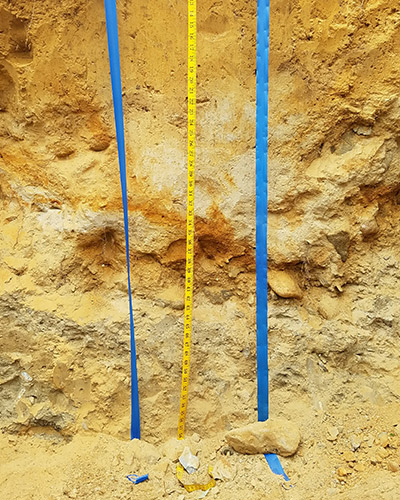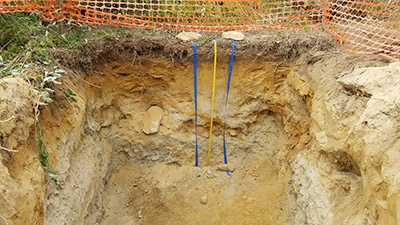Soil Evaluation
The actual treatment of sanitary wastewater effluent, in the form of biological and/or non-biological
processes, generally occurs in the soil beneath the soil absorption system. Having recognized that soil is
a vital component of the on-site disposal system, the MassDEP has implemented a methodology for
characterizing and assessing a site’s ability to accept and treat effluent. This methodology is known as
soil evaluation, and Title 5 requires that it be performed by a certified “Soil Evaluator”. The Soil
Evaluator evaluates the potential of a site to accept and treat effluent by performing deep observation
hole testing, and determining soil profiles on site.
Title 5 requires a minimum of two deep observation hole tests at every proposed disposal area,
including two in the primary area and two in a reserve area, if applicable. The deep observation holes
must be a minimum of 10-feet deep unless such depth is unattainable due to bedrock/ refusal or high
groundwater. Once the deep observations holes are dug, the Soil Evaluator prepares a Form 11: Soil
Suitability Assessment for On-Site Sewage Disposal characterizing the recognizable soil properties and
high ground-water elevation.
Soil properties that are of interest are:
- Geologic Deposits – There are eight broad groupings of unconsolidated geologic sediments
occurring within New England. Knowing the geology of a site is crucial to understanding how a
site will impact adjacent areas and will help narrow the focus of an on-site investigation to key
issues. Types of geologic deposits include but are not limited to Glacial Till, Lakebed Sediments,
Floodplain Deposits, and Shallow to Bedrock areas.
- Soil Horizon and Layers – Strata within the soil that are typically parallel to the ground surface.
They may differ from one another by color, feel, texture, presence of rock fragments, etc. There
are six major distinctions used to designate horizons and layers in the soil: O, A, E, B, C and R.
- Soil Texture – Refers to the relative proportion of sand, silt, and clay in a soil. Particle size and
distribution are key factors in determining the rate of water movement through a soil.
- Soil Structure – The arrangement of individual soil particles into compound particles or
aggregates.
- Soil Consistence – The feel of the soil and the ease with which a lump can be crushed by the
fingers.
- Soil Color – The most obvious and easily determined soil characteristic. Although it has little
known direct influence on the function of the soil, color is one of the most useful properties or
soil identification and interpretation. Well-drained soils have bright colors in the subsoil, while
soils with a fluctuating seasonal high water table typically have blotchy color pattern of gray,
yellow, and orange.
- Redoximorphic Features – Color patterns in the soil that are caused by chemical reduction and
oxidation of iron and manganese compounds in the soil. Redox features indicate poor aeration
and impeded drainage, as well as areas of fluctuating water levels which may indicate seasonal
high ground-water elevation.
Once the soil evaluation is completed, a percolation test is required to approximate the soils hydraulic
capacity to a depth of four feet below the bottom of the soil absorption system. The soil evaluation and
percolation test results are then used as the basis of design for the soil absorption system.



